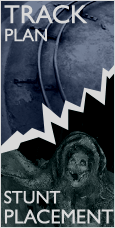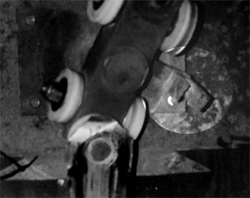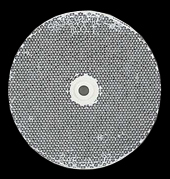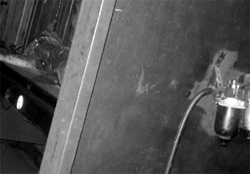 |
 |
 |
|||
 |
|||||
   
Home > Interior > Stunts > How They Work  Explore the attraction's stunts >  With advancements in technology, it is not surprising that amusement parks are implementing the use of modern-age electroics to help achieve a smooth operation of their attractions.  In recent years, the Haunted House management has implemented the use of photoelectric beam sensing switches to activate the stunts rather than the unreliable horseshoe magnetic trips that Bill Tracy installed in 1964. Shown below is the original horseshoe that was mounted near the "Unit" on the bottom of the car.  In the early days, a small magnetic horseshoe was mounted to the underside of the vessel and tripped small magnetic switches which were mounted to small blocks of wood and placed near the track next to each corresponding stunt. This technique, although very inexpensive, proved to be troublesome and required a lot of maintenance. If the horseshoe was not aligned perfectly, the car would risk missing all of the track switches, which would result in an attraction full of motionless stunts. Likewise, because the magnetic switches were near the track, if one of them happened to get damaged or accidentally stepped on by an employee, it could damage the wire connectors or the switch itself.
In the early days, a small magnetic horseshoe was mounted to the underside of the vessel and tripped small magnetic switches which were mounted to small blocks of wood and placed near the track next to each corresponding stunt. This technique, although very inexpensive, proved to be troublesome and required a lot of maintenance. If the horseshoe was not aligned perfectly, the car would risk missing all of the track switches, which would result in an attraction full of motionless stunts. Likewise, because the magnetic switches were near the track, if one of them happened to get damaged or accidentally stepped on by an employee, it could damage the wire connectors or the switch itself. After it was decided that the switches needed an upgrade in order to give every customer a flawless ride experience, small photoelectric switches were purchased along with their corresponding circular reflectors. Ever since these devices were installed, the stunts have been running beautifully without fail.  The switch itself is similar (but not identical) to the image on the right and emits an invisible beam horizontally across the path of the vessel. On the opposite side of the path, a circular beam reflector is mounted. In essence, the photoelectric switch sends a beam to the reflector and it is reflected back the unit, completing the switch circuit. The alignment of the switch and reflector must be precise or the switch will not work. When the vessel creeps by, it breaks the beam (or the circuit) which triggers the stunt to activate. The switch itself is similar (but not identical) to the image on the right and emits an invisible beam horizontally across the path of the vessel. On the opposite side of the path, a circular beam reflector is mounted. In essence, the photoelectric switch sends a beam to the reflector and it is reflected back the unit, completing the switch circuit. The alignment of the switch and reflector must be precise or the switch will not work. When the vessel creeps by, it breaks the beam (or the circuit) which triggers the stunt to activate. When the car passes, the beam is reinstated and the stunt goes back to its previous position. You can see a mounted beam reflector on the Sawmill here and the photoelectric switch that actives the Jumping Ghoul upstairs can be seen here. When the car passes, the beam is reinstated and the stunt goes back to its previous position. You can see a mounted beam reflector on the Sawmill here and the photoelectric switch that actives the Jumping Ghoul upstairs can be seen here.To prevent the photoelectric switches to be activated by an employee walking by, they are set at intervals greater than that of the quick movement a person would make walking by. More likely than not, it is set for one second, which would mean the beam would be broken for at least one second before the stunt would be activated. At the slow speed of the vessel, this interval is ideal for the stunt activation. If an employee were to stand in the beamís path for 1+ second(s), naturally, the stunt would be activated.   The majority of stunts inside Trimperís Haunted House are powered by pneumatic air pistons that are activated by photoelectric switches. Currently, the stunts that require air for operation are :
 In essence, each stunt that was designed to move with air includes a pivot point or track. This allows the stunt to move freely but in a controllable matter. An air piston, similar to that seen to the right, is attached to the pivot point in order to give it life. The stuntís ending position is configured with the piston fully extended, while the stuntís original position before animation would be configured with a decompressed piston. In essence, each stunt that was designed to move with air includes a pivot point or track. This allows the stunt to move freely but in a controllable matter. An air piston, similar to that seen to the right, is attached to the pivot point in order to give it life. The stuntís ending position is configured with the piston fully extended, while the stuntís original position before animation would be configured with a decompressed piston.Each stunt that requires air includes a heavy-duty air line that is routed back to the compression room, which is located in the Graveyard. The compression room houses the air compressor that supplies air to each stunt. When the switch is triggered by the vessel, the valve at the stunt opens allowing air to charge the piston(s), therefore making the stunt move. The air lines throughout the ride remain constantly charged. And, thanks to a relay, the piston will remain compressed for a given amount of time (in seconds) and will release after the designated time is up.  When the air compressor compresses air into its tank, it creates condensation; when air is compressed, any moister in the air generally tends to separate from the air itself. This condensation, although minimal, can damage a piston to great extremes, or it can compromise the pistonís ability to operate sufficiently. The prevent condensation from circulating through the air lines to each individual stunt, air filters have been installed to filter the compressed air from water or other contaminants. As seen to the right, the filters are mounted next to their coinciding stunts. This filter happens to belong to the Sawmill. Every now and then, the valve at the base of the filter will have to be loosened to allow and condensation collected to discharge. This simple step allows flawless functionality to the pneumatic pistons which power each stunt. Needless to say, if a piston ever needs replacing, they tend to have a pretty hefty price tag. When the air compressor compresses air into its tank, it creates condensation; when air is compressed, any moister in the air generally tends to separate from the air itself. This condensation, although minimal, can damage a piston to great extremes, or it can compromise the pistonís ability to operate sufficiently. The prevent condensation from circulating through the air lines to each individual stunt, air filters have been installed to filter the compressed air from water or other contaminants. As seen to the right, the filters are mounted next to their coinciding stunts. This filter happens to belong to the Sawmill. Every now and then, the valve at the base of the filter will have to be loosened to allow and condensation collected to discharge. This simple step allows flawless functionality to the pneumatic pistons which power each stunt. Needless to say, if a piston ever needs replacing, they tend to have a pretty hefty price tag.    To coincide with the stunt activation, each stunt inside the Haunted House works on a relay as seen to the right. On each relay, the number of seconds a stunt is activated can be programmed. As an example, the Knit-Wit works on a pneumatic cylinder which is compressed with air when triggered and therefore rotates the pedestal 180 degrees until the stunt faces you. It faces you for five seconds, then returns to its normal position. The relay is what allows it to face you for those five seconds, instead of returning immediately after the cylinder is compressed. On the relay, ďfive secondsĒ is programmed. Likewise, when you enter the Upside-down room, a small light turns on when you enter. The light is on for five seconds, and then turns off. That five second interval is executed by a relay. To coincide with the stunt activation, each stunt inside the Haunted House works on a relay as seen to the right. On each relay, the number of seconds a stunt is activated can be programmed. As an example, the Knit-Wit works on a pneumatic cylinder which is compressed with air when triggered and therefore rotates the pedestal 180 degrees until the stunt faces you. It faces you for five seconds, then returns to its normal position. The relay is what allows it to face you for those five seconds, instead of returning immediately after the cylinder is compressed. On the relay, ďfive secondsĒ is programmed. Likewise, when you enter the Upside-down room, a small light turns on when you enter. The light is on for five seconds, and then turns off. That five second interval is executed by a relay. The relay is in essence a timer for each stunt or lighting effect and can be used for a number of applications. As a side note, a relay is also used for the ďgo aheadĒ buzzer in the lobby which signals the ride operator to send the next vessel. The trip for this buzzer is located in the second room (Crooked Timbers) and is on a relay set for five seconds. Relays are crucial parts of the ride, and luckily, they require little maintenance.   While air is the primary method for stunt animation, electric motors are essential, too. The stunts that require electric motors are:
Whether they use air or AC electric motors, the stunts are always more enjoyable when animated. Thanks to the commitment of the Haunted House management, animation problems are often quickly addressed in order to give every rider a superb riding experience. As technology changes, so will the behind-the-scenes aspects of the Haunted House. Hopefully, the technology applied to the attraction will make the riderís experiences more enjoyable without compromising its historical and classical stature.   Enjoy viewing some of the mechanisms that make the stunts operate.
  Home | Preface | Updates | Interior | Exterior Features | Archive | Media | Visit | Store | Connect This website is in no way affiliated with Trimpers Rides & Amusements ochh.net | forum.ochh.net Sitemap | |||||